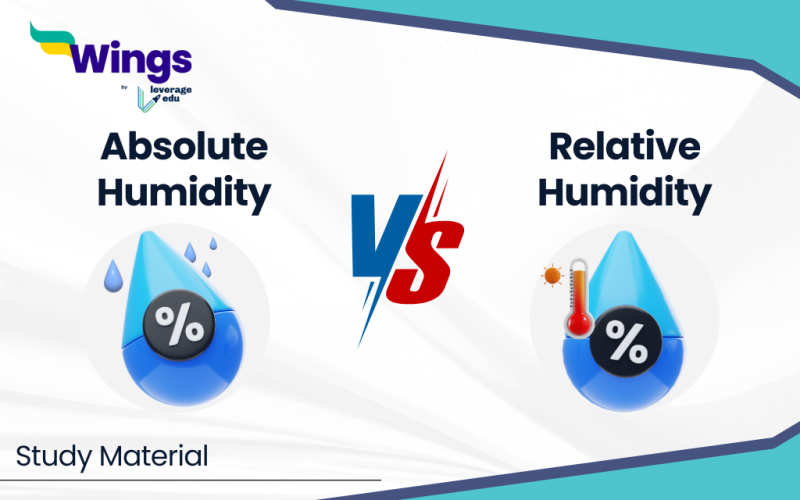The Difference between Absolute and Relative Humidity is in how they quantify moisture in the air. Absolute humidity measures the actual amount of water vapour present in the air, whereas relative humidity expresses this moisture level relative to the maximum capacity of air to hold moisture at a given temperature.
Absolute Humidity tells you the mass of water vapour per unit volume of air. It’s a direct measure of how much moisture is present, like grams of water vapour per cubic metre (g/m3), like the number of people in the room. On the other hand, Relative Humidity expresses the amount of water vapour in the air as a percentage of the maximum amount the air could hold at that temperature. So, it considers how close the air is to saturation, like in the same room with only a certain number of seats.
Table of Contents
What is Absolute Humidity?
Absolute humidity is a simple way of measuring the amount of water vapour present in the air. It tells you exactly how much moisture is there, regardless of the air temperature. Unlike relative humidity, it doesn’t take the air temperature into account.
- Measurement: It’s expressed as the mass of water vapour per unit volume of air, Common units grams per cubic metre (g/m3), or kilograms per cubic metre (kg/m3).
- Interpretation: Higher absolute humidity values indicate more water vapour in the air. So, 15 g/m3 of absolute humidity means there are 15 grams of water vapour in each cubic meter of air.
- Independence from Temperature: Absolute humidity remains constant regardless of air temperature, as long as no moisture is added or removed from the air.
What is Relative Humidity?
Relative Humidity also known as RH, is a way to express how much moisture is in the air compared to the maximum amount of the air could hold at a specific temperature. It’s essentially a percentage, reflecting how close the air is to saturation, a point where it can’t hold any more water vapor.
- Measurement: Expressed as a percentage (%).
- Interpretation
- High RH (above 60%) indicates the air is close to its capacity for holding moisture and feels muggy or sticky.
- Low RH (below 40%) suggests the air is dry and can absorb more moisture, making it feel dry or uncomfortable.
- Dependence on Temperature: Warm air can hold more moisture than cold air. So, the same amount of water vapour can result in different relative humidity readings depending on the temperature.
- Warm air: With higher temperatures, the maximum moisture holding capacity increases. Even if the absolute humidity stays the same, the RH will be lower because the air is further from saturation.
- Cool air: Conversely, cooler air has a lower capacity for moisture. The same amount of water vapour can lead to a higher RH as the air is closer to its saturation point.
Also Read: Difference Between GHz and MHz
What is the Difference Between Absolute and Relative Humidity?
The following table summarises the main differences between absolute and relative humidity.
| Particular | Absolute Humidity | Relative Humidity |
| Definition | The actual amount of water vapor present in the air | Amount of moisture in the air relative to its maximum capacity |
| Measurement Unit | Grams per cubic meter (g/m³) or grains per cubic foot (gr/ft³) | Percentage (%) |
| Focus | Directly measures moisture content in the air | Indicates how close the air is to saturation at a given temperature |
| Temperature Effect | Doesn’t depend on temperature changes | Depends on temperature changes |
| Example | If there are 10 grams of water vapour in 1 cubic meter of air, the absolute humidity is 10 g/m³ | If the air is at 50% relative humidity, it means the air contains half the moisture it could hold at that temperature |
Difference Between Absolute and Relative Humidity Formulas
Absolute Humidity Formula
Absolute humidity (AH) is calculated using the following formula:
| AH = (ρw x Rw x T) / (1000 x Pv) |
Where:
- AH – Absolute humidity (g/m³)
- ρw – Density of water vapour (kg/m³) (often assumed to be the same as air density for simplicity)
- Rw – Gas constant for water vapor (J/(kg⋅K)) (approximately 461.5 J/(kg⋅K))
- T – Air temperature (K)
- Pv – Saturation vapour pressure (Pa)
Note:
- This formula is more complex and requires knowledge of additional parameters like the density of water vapor and saturation vapour pressure.
- Saturation vapour pressure (Pv) is a function of temperature and can be found in psychrometric charts or tables, or through various scientific equations.
Relative Humidity Formula
Relative humidity (RH) is a simpler calculation and can be derived from absolute humidity and saturation vapour pressure:
| RH = (AH / Ps) x 100% |
Where:
- RH – Relative humidity (%)
- AH – Absolute humidity (g/m³) (as calculated above or measured with a device)
- Ps – Saturation vapour pressure (Pa) (same as in the absolute humidity formula)
Note:
- This formula is more commonly used as it only requires absolute humidity, which can be measured directly, and saturation vapour pressure.
Finding Absolute Humidity from Relative Humidity
You can also rearrange the relative humidity formula to solve for absolute humidity:
| AH = (RH x Ps) / 100% |
Application of Difference Between Absolute and Relative Humidity in Real Life
Absolute humidity and relative humidity might seem like scientific concepts, but they have many practical applications in our everyday lives. Here’s a breakdown of how they are used in different areas.
Absolute Humidity
- In weather forecasting, absolute humidity is crucial for understanding the total amount of moisture available in the atmosphere.
- Many industrial processes require precise control of moisture levels. For example, in manufacturing pharmaceuticals or food products, absolute humidity is monitored to ensure product quality and consistency.
- Construction professionals use absolute humidity data to manage condensation and prevent mould growth in buildings.
Relative Humidity
- Relative humidity plays a significant role in how comfortable we feel. Low relative humidity can cause dry skin, irritated respiratory systems, and static electricity.
- The relative humidity is critical for plant growth and storage.
- Maintaining a stable relative humidity level is essential for preserving delicate artefacts like paintings, books, and textiles.
Also Read: What is the Difference Between Device and Machine? Complete Details
FAQ’s
AH stands for “air humidity.” RH is the difference between AH and the largest AH that can be reached at a certain temperature and pressure.
When you measure relative humidity, you compare how much water is in the air to the most water that could be in the air, which is called the highest vapour pressure. Absolute humidity measures the exact amount of water that is in the air. Absolute humidity is the amount of water vapour that is actually in the air, no matter what the temperature is.
When RH is above 65%, mould can grow and metal can rust. High RH (above 25%) can weaken hygroscopic materials like leather and paper.
RELATED BLOGS
This was all about the “Difference between Absolute and Relative Humidity”. For more such informative blogs, check out our Study Material Section, you can learn more about us by visiting our Indian exams page.
 One app for all your study abroad needs
One app for all your study abroad needs













